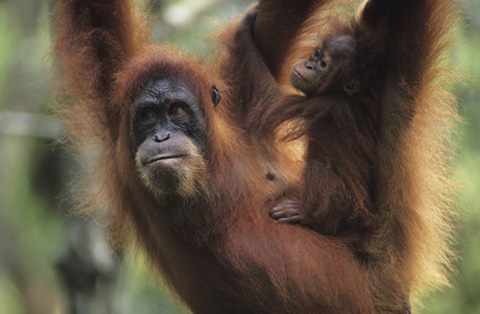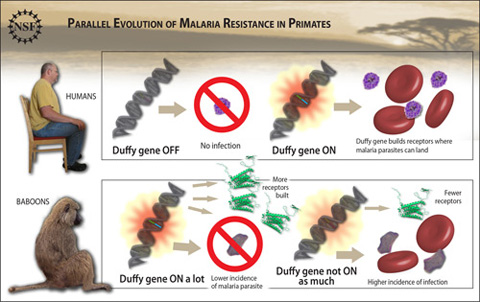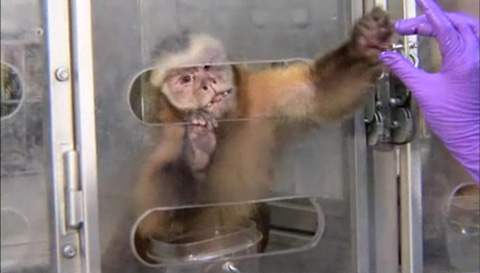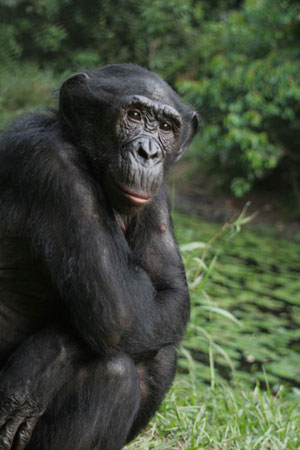Navigation
Scientists Determine What Makes an Orangutan an Orangutan
For the first time, scientists have mapped the genome--the genetic code--of orangutans. This new tool may be used to support efforts to maintain the genetic diversity of captive and wild orangutans.
 |
| For the first time, scientists have mapped the genome--the genetic code--of orangutans. This new tool may be used to support efforts to maintain the genetic diversity of captive and wild orangutans. The new map of the orangutan genome may also be used to help improve our understanding of the evolution of primates, including humans. There are two species of orangutans, defined primarily by their island of origin--either Sumatra or Borneo. The decline of the Sumatran and Borneo populations of orangutans is caused by varied threats, such as illegal logging, the conversion of rain forests to farmland and palm oil plantations, hunting and diseases. Using a mix of legacy and novel technologies, the research team mapped the genomes of a total of 11 orangutans, including representatives of both the Sumatran and Bornean species. Credit: © 2011 Jupiter Images Corporation |
For the first time, scientists have mapped the genome--the genetic code--of orangutans. This new tool may be used to support efforts to maintain the genetic diversity of captive and wild orangutans. The new map of the orangutan genome may also be used to help improve our understanding of the evolution of primates, including humans.
Partially funded by the National Science Foundation, the orangutan study appears in the Jan. 27 issue of Nature. It was conducted by an international team of scientists led by Devin P. Locke of the Genome Center at Washington University.
Conservation implications
The name "orangutan" is derived from the Malay term, "man of the forest," a fitting moniker for one of our closest relatives.
There are two species of orangutans, defined primarily by their island of origin--either Sumatra or Borneo. The outlook for orangutan survival is currently dire because there are estimated to be only about 7,500 orangutans in Sumatra, where they are considered critically endangered, and only about 50,000 orangutans in Borneo, where they are considered endangered.
The endangerment status of orangutans is determined by the International Union for Conservation of Nature.
There are no other wild populations of orangutans other than those in Sumatra and Borneo. The decline of the Sumatran and Borneo populations of orangutans is caused by varied threats, such as illegal logging, the conversion of rain forests to farmland and palm oil plantations, hunting and diseases.
Using a mix of legacy and novel technologies, the research team mapped the genomes of a total of 11 orangutans, including representatives of both the Sumatran and Bornean species.
The map of the orangutan genome may support conservation efforts by helping zoos create breeding programs designed to maintain the genetic diversity of captive populations. (The greater the genetic diversity of a species, the more resilient it is against threats to its survival.) The genome map may also help conservationists sample the genetic diversity of wild populations so they can prioritize populations of wild orangutans for conservation efforts.
Evolutionary implications
After scientists map a species' genome, they compare it to the genetic maps of other species. As they do so, they search for key differences that involve duplications, deletions and inversions of genetic material. These differences may contribute to the unique features of particular species. They may also provide information about general evolutionary trends, such as the overall rate at which genomic evolution has occurred.
Before the orangutan's genome was mapped, the genetic codes of three other great primates--humans, chimpanzees and rhesus macaques--were mapped.
The genomes of the gorilla and bonobo will soon be mapped, as well.
Analyses of the orangutan genome reveal that this primate has many unique features. For example, comparisons of the structural variation of the genomes of orangutans, humans, chimpanzees and rhesus macaques indicate that during the last 15 million years or so of primate evolution, the orangutan genome has generally been more stable than those of the other primates, with fewer large-scale structural changes.
The orangutan genome also allowed for an analysis of fast-evolving genes, which are likely to have responded to evolutionary pressure for adaptation. Genes related to visual perception and metabolic processes were found to evolve unusually rapidly in orangutans and other primates. The orangutan's metabolism-related genes were also found to have evolved rapidly--a phenomenon that may be related to the organgutan's slow growth rate, slow reproduction rate, and long inter-birth interval, the period between successive births. Organutans give birth not more than once every six to eight years, an inter-birth interval rated as the longest among mammals, including humans.
Comparisons of the population genetics of the Sumatran and Bornean species indicate that these species split approximately 400,000 years ago, which is more recent than previously believed. In addition, Sumatran orangutans have greater genetic diversity than their Bornean counterparts, despite their smaller population size and higher endangered status.
Adam Siepel, a research team member from Cornell University described the new map of the genetic code of orangutans as an important step in genome sequencing of primates. "The orangutan genome gives us a much more complete picture of genome evolution in the great apes," he said.
"This is a terrific example of the application of genome sequencing beyond model organisms--well-studied organism like the mouse and fruit fly," said Reed Beaman, an NSF program director. "Research like this has only recently become possible through a dramatic decrease in the cost of sequencing. These results demonstrate broad significance to biogeography, genetics, as well as to conservation and human evolution, and they are only starting to scratch the surface."
This news is from the the National Science Foundation
Orangutan Copy Cats
How smart are copy cats? Maybe it depends on your species
You know the saying "monkey see, monkey do?" How about "orangutan see, orangutan do?" If that holds true, the small orangutan peering over his mother's shoulder in an enclosure at Zoo Atlanta should learn how to get a tasty treat just by watching how she gets one.
 |
| Researchers at the Duke University Institute for Genome Sciences & Policy have found that variation in the same gene in humans and baboons produces the same kind of disease resistance. Credit: Zina Deretsky, National Science Foundation |
"One of the questions that we were looking at is how individuals learn from one another," says Marietta Dindo, a primatologist studying orangutans and their behaviors. With support from the National Science Foundation (NSF) and in affiliation with the National Zoo in Washington, D.C., Dindo is studying these endangered primates to better understand how our distant ape cousins watch and learn.
"What's interesting and unique about orangutans compared to humans or even other great apes is the fact they're what we call "solitary but social," which means that the individuals, aside from a mother-offspring interaction, will only have limited times where they spend in affiliation with other orangutans," explains Dindo.
Since orangutans in the wild are difficult to observe, Dindo designed an experiment with captive animals. "We had 13 orangutans at the time of the study, and this allowed us to look at what we call a transmission chain: individuals learning like in the game of telephone. I tell you something, then you tell him something and so on, how does that information then pass on? We wanted to see whether or not these orangutans would learn," she continues.
 |
| Psychologist and neuroscientist Sarah Brosnan from Georgia State conducted a study with chimpanzees that helped prove that the sense of inequity and fairness runs deep in the primate family tree. Brosnan decided to test another common trait. She set out to see if cooperation, like fair play, is baked into our DNA. To test the notion, she assembled a team of researchers. Senior research scientist Michael Beran helped her test chimpanzees and rhesus and capuchin monkeys. Bart Wilson, professor of law and economics at Chapman University in California, orchestrated similar games for humans to play. Monkeys and humans had the same success rate--they cooperated about 70 to 80 percent of the time. That suggests that cooperative behavior runs deep in the nature of primates. The only time humans outscored monkeys was when the students employed a key advantage--language. See more in this Science Nation video at the bottom of this artilcle. Credit: Science Nation, National Science Foundation |
Dindo built a small plastic box with a small door and attached it to the bars of the cage. It allowed the orangutans to slide or lift the door open, and she would give them a treat through the door. Regardless of which method the orangutans used to get the door open, they could always collect a treat behind the door. This meant that the only motivation to conform to one method over the other was what an individual observed another orangutan doing.
In the demonstration, the female orangutan named Madu figured it out right away. Her son, little Dumadi, was paying close attention, but in this case, big mama Madu was so dominant, she kept him at bay and wouldn't let him touch the door. In the actual study, Dindo found equally matched orangutans were superb copy cats, and learned from each other. She also explains that even though they are able copy cats, other studies have shown that apes will only copy each other when it serves their purposes.
"It's known from other research studies that apes won't actually imitate unnecessary actions if they know it's unnecessary," notes Dindo.
Does this orangutan behavior tell us anything about how humans have evolved? Dindo says studies show humans aren't nearly as selective as orangutans. We'll ape each other just to be part of the group. "With humans, what we see is that people want to do as others do and this starts around three years of age--when we start identifying ourselves with others," she says.
 |
| Brian Hare, assistant professor of evolutionary anthropology at Duke University, spends several months of the year in the Democratic Republic of Congo, where he studies bonobos like the one above. He focuses on their behavior, specifically on how they solve problems and interact with other bonobos. Bonobos are genetically close to humans, yet most people know very little about them. Recently, Hare and his colleagues found that bonobos are natural sharers. The researchers' work described how bonobos enjoy sharing food with other bonobos, and never outgrow their willingness to do so--unlike chimpanzees that become more selfish when they reach adulthood. Credit: Vanessa Woods, Duke University |
So when it comes to following the crowd you might argue that orangutans are more on the ball than we are since they seem to imitate only those actions that they have discovered are necessary to produce the desired outcome the quickest. Meanwhile, humans tend to follow others more precisely and, sometimes, even over imitate to get a similar desired outcome.
However, Dindo is quick to point out that it really depends on your point of view: "Is it intelligent to be as others--when it's so integral to our society and the cultural norm is to do as others do? Well, then yes, it's very smart," says Dindo. "But if you're not going to want to waste your resources and you want to get to your food fast, then that, too, is very smart. So it really depends on where you're coming from."
Authors:
Miles O'Brien, Science Nation Correspondent
Ann Kellan, Science Nation Producer
Related Links:
This article is from Science Nation, 7 February 2011
Search
Latest articles
Agriculture
- World Water Week: Healthy ecosystems essential to human health: from coronavirus to malnutrition Online session Wednesday 24 August 17:00-18:20
- World Water Week: Healthy ecosystems essential to human health: from coronavirus to malnutrition Online session Wednesday 24 August 17:00-18:20
Air Pollution
- "Water and Sanitation-Related Diseases and the Changing Environment: Challenges, Interventions, and Preventive Measures" Volume 2 Is Now Available
- Global Innovation Exchange Co-Created by Horizon International, USAID, Bill and Melinda Gates Foundation and Others
Biodiversity
- It is time for international mobilization against climate change
- World Water Week: Healthy ecosystems essential to human health: from coronavirus to malnutrition Online session Wednesday 24 August 17:00-18:20
Desertification
- World Water Week: Healthy ecosystems essential to human health: from coronavirus to malnutrition Online session Wednesday 24 August 17:00-18:20
- UN Food Systems Summit Receives Over 1,200 Ideas to Help Meet Sustainable Development Goals
Endangered Species
- Mangrove Action Project Collaborates to Restore and Preserve Mangrove Ecosystems
- Coral Research in Palau offers a “Glimmer of Hope”
Energy
- Global Innovation Exchange Co-Created by Horizon International, USAID, Bill and Melinda Gates Foundation and Others
- Wildlife Preservation in Southeast Nova Scotia
Exhibits
- Global Innovation Exchange Co-Created by Horizon International, USAID, Bill and Melinda Gates Foundation and Others
- Coral Reefs
Forests
- NASA Satellites Reveal Major Shifts in Global Freshwater Updated June 2020
- Global Innovation Exchange Co-Created by Horizon International, USAID, Bill and Melinda Gates Foundation and Others
Global Climate Change
- It is time for international mobilization against climate change
- It is time for international mobilization against climate change
Global Health
- World Water Week: Healthy ecosystems essential to human health: from coronavirus to malnutrition Online session Wednesday 24 August 17:00-18:20
- More than 400 schoolgirls, family and teachers rescued from Afghanistan by small coalition
Industry
- "Water and Sanitation-Related Diseases and the Changing Environment: Challenges, Interventions, and Preventive Measures" Volume 2 Is Now Available
- Global Innovation Exchange Co-Created by Horizon International, USAID, Bill and Melinda Gates Foundation and Others
Natural Disaster Relief
- STOP ATTACKS ON HEALTH CARE IN UKRAINE
- Global Innovation Exchange Co-Created by Horizon International, USAID, Bill and Melinda Gates Foundation and Others
News and Special Reports
- World Water Week: Healthy ecosystems essential to human health: from coronavirus to malnutrition Online session Wednesday 24 August 17:00-18:20
- STOP ATTACKS ON HEALTH CARE IN UKRAINE
Oceans, Coral Reefs
- World Water Week: Healthy ecosystems essential to human health: from coronavirus to malnutrition Online session Wednesday 24 August 17:00-18:20
- Mangrove Action Project Collaborates to Restore and Preserve Mangrove Ecosystems
Pollution
- Zakaria Ouedraogo of Burkina Faso Produces Film “Nzoue Fiyen: Water Not Drinkable”
- "Water and Sanitation-Related Diseases and the Changing Environment: Challenges, Interventions, and Preventive Measures" Volume 2 Is Now Available
Population
- "Water and Sanitation-Related Diseases and the Changing Environment: Challenges, Interventions, and Preventive Measures" Volume 2 Is Now Available
- "Water and Sanitation-Related Diseases and the Changing Environment: Challenges, Interventions, and Preventive Measures" Volume 2 Is Now Available
Public Health
- Honouring the visionary behind India’s sanitation revolution
- Honouring the visionary behind India’s sanitation revolution
Rivers
- World Water Week: Healthy ecosystems essential to human health: from coronavirus to malnutrition Online session Wednesday 24 August 17:00-18:20
- Mangrove Action Project Collaborates to Restore and Preserve Mangrove Ecosystems
Sanitation
- Honouring the visionary behind India’s sanitation revolution
- Honouring the visionary behind India’s sanitation revolution
Toxic Chemicals
- "Water and Sanitation-Related Diseases and the Changing Environment: Challenges, Interventions, and Preventive Measures" Volume 2 Is Now Available
- Actions to Prevent Polluted Drinking Water in the United States
Transportation
- "Water and Sanitation-Related Diseases and the Changing Environment: Challenges, Interventions, and Preventive Measures" Volume 2 Is Now Available
- Urbanization Provides Opportunities for Transition to a Green Economy, Says New Report
Waste Management
- Honouring the visionary behind India’s sanitation revolution
- Honouring the visionary behind India’s sanitation revolution
Water
- Honouring the visionary behind India’s sanitation revolution
- Honouring the visionary behind India’s sanitation revolution
Water and Sanitation
- Honouring the visionary behind India’s sanitation revolution
- Honouring the visionary behind India’s sanitation revolution

